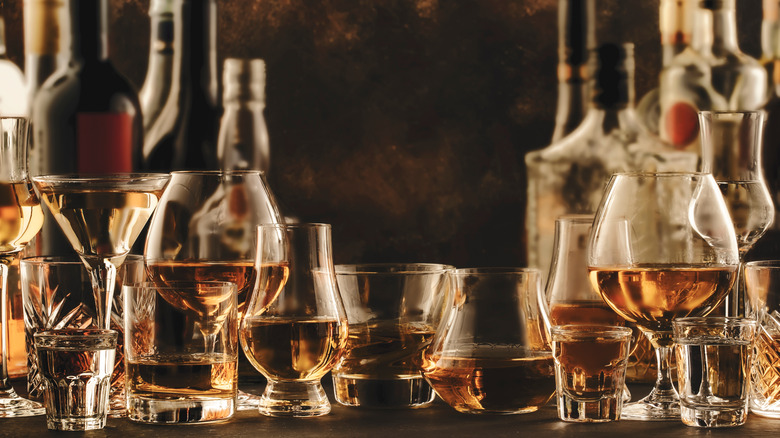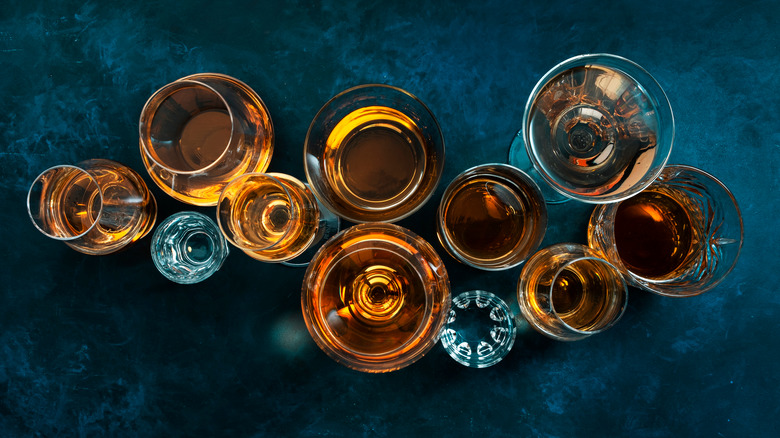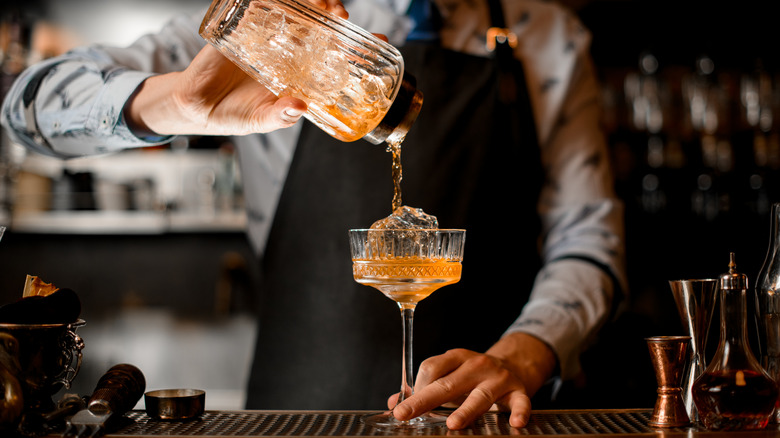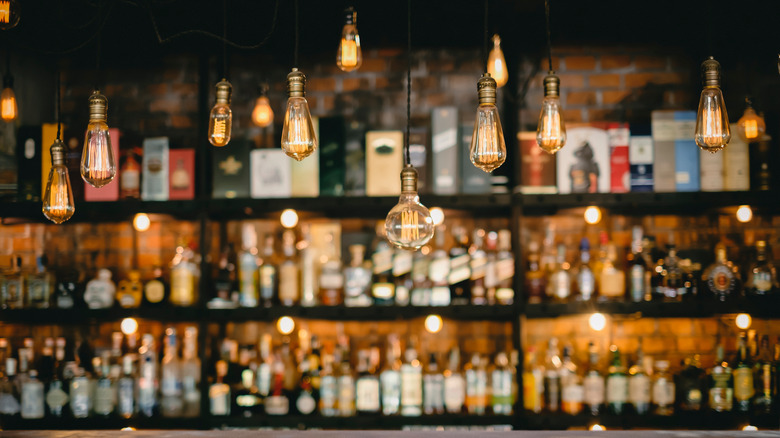What's The Difference Between Liquor And Liqueur?
Poet Ogden Nash famously wrote, "Candy is dandy, but liquor is quicker." Nash had his head on straight, as there's some truth to the phrase. But are liquor and liqueur the same thing? And if they aren't, which is quicker?
In the case of "liqueur," candy and alcohol aren't as mutually exclusive. Liqueur, in general, is much sweeter than a standard spirit, per Barsys. But why? Every spirit on the backbar has its own unique purpose as part of the mixologist's tool kit, the sweet and the "quick" alike. It's time to debunk the liquor vs. liqueur debate and determine once and for all what makes them different.
Liqueurs are a type of liquor, but not every liquor is a liqueur. Their flavor profiles, fermentation, ABV, and their uses behind the bar distinctly separate them into two different classes of spirits. Let's break down what really goes into your favorite cocktails.
What is liquor, really?
Liquor may be what comes to mind when many think of the word "alcohol." According to Business Insider, liquor is a catchall term for any hard spirit that has a higher alcohol-by-volume (ABV) than wine or beer. American guidelines set the standard serving of wine at 5 ounces, containing 12% alcohol, and 12 ounces for beer, around 5% alcohol, via Stanford University.
Liquor includes the most common spirits on the back bar, such as Absolut, Jack Daniel's, Espolòn, Sailor Jerry, Rémy Martin, and Evan Williams. These represent the six variations of liquor: vodka, rum, tequila, bourbon, brandy, and whiskey or "whisky," depending on its region of origin.
Fermentation is essential to crafting and differentiating the various types of liquor. MasterClass maintains that for a hard alcohol or spirit to even be included in the liquor category, it must undergo fermentation and distillation processes. Liquors start with an organic base: grain or plants, depending on which liquor it's destined to be. In the distillation process, it explains, heat and condensation cause a significant portion of the water to boil off, thereby concentrating the alcohol and increasing the alcohol content.
Per A1 Wine and Spirit, once the fermentation process is complete, the distillation process begins, during which the liquid is purified and the alcohol content increases by at least 20% per volume. Tequila, vodka, and rum have an ABV of 40%, while whiskey clocks in at 55%, reports A1.
What is liqueur?
Think of liqueur as the cherry on top of a cocktail. A rocks glass of vodka is just fine (glorious, even) on its own. But, add a few ounces of coffee liqueur (like this liqueur made from cold brew concentrate by up-and-coming Australian brand Mr. Black) and you've got a White Russian.
To US mixologists, the word "liqueur" is interchangeable with "cordial." According to A1 Wine and Spirit, liqueurs are also the historical descendants of herbal medicines crafted by Italian monks that can be traced as far back as the 13th century. Today, popular liqueur brands include Cointreau, Baileys, Campari, Lazzaroni Amaretto, Frangelico, and Aperol — most famous as the key ingredient in an Aperol Spritz cocktail.
Of course, a rocks glass of liqueur is hunky dory on its own, too. Garnish is as garnish does; sip as you please. Liqueur is largely a flavor enhancer, says Business Insider, with sweet, citrusy, or herbaceous notes that complement the base liquor in a cocktail. Many bar-goers opt for a potable liqueur cocktail and forgo the liquor base altogether; a few drops of spiced orange Angostura bitters in soda water is a popular combo.
The difference between liquor and liqueur
The two key differences between liquor and liqueur are flavor and ABV.
According to Curacao Liqueur, the most important factor to take into consideration when talking about spirits is sugar. Liquor, it says, has zero to little added sugar and no additional flavors. Conversely, the average liqueur contains 3 grams of sugar per 1 fluid ounce. Flavoring herbs and oils and added sugar influence the taste of liqueurs, and also have a small but perceptible effect on their texture versus traditional liquor, via MasterClass.
A1 Wine and Spirit differentiates liquor from liqueur solely based on ABV. Drinks with an ABV higher than 35%, it says, should be considered liquors, and all drinks having less than 35% ABV should be considered liqueurs. From there, the potency range is pretty wide in either direction. MasterClass reports that most liquors have an ABV of 40-55%. Liqueurs, which typically contain more flavoring ingredients which slash the alcohol concentration, usually have much lower ABVs, around 15-30%.
So, with this in mind, next time your bartender hits you with, "What'll it be?" — You'll know exactly what you want to order and why. Liquor might be quicker, but candy's also pretty dandy.



